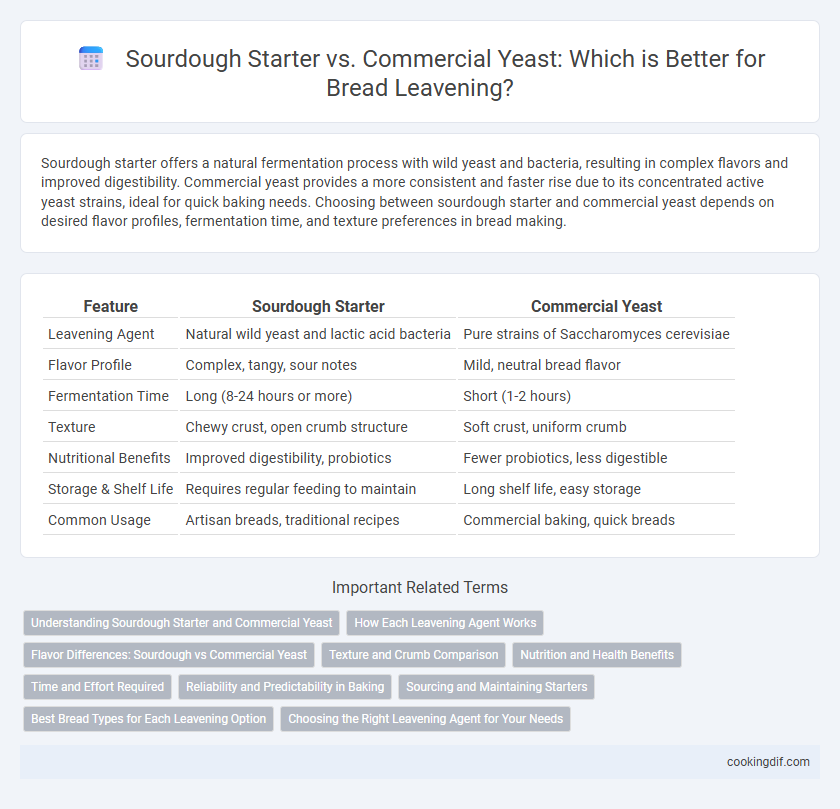Sourdough starter offers a natural fermentation process with wild yeast and bacteria, resulting in complex flavors and improved digestibility. Commercial yeast provides a more consistent and faster rise due to its concentrated active yeast strains, ideal for quick baking needs. Choosing between sourdough starter and commercial yeast depends on desired flavor profiles, fermentation time, and texture preferences in bread making.
Table of Comparison
| Feature | Sourdough Starter | Commercial Yeast |
|---|---|---|
| Leavening Agent | Natural wild yeast and lactic acid bacteria | Pure strains of Saccharomyces cerevisiae |
| Flavor Profile | Complex, tangy, sour notes | Mild, neutral bread flavor |
| Fermentation Time | Long (8-24 hours or more) | Short (1-2 hours) |
| Texture | Chewy crust, open crumb structure | Soft crust, uniform crumb |
| Nutritional Benefits | Improved digestibility, probiotics | Fewer probiotics, less digestible |
| Storage & Shelf Life | Requires regular feeding to maintain | Long shelf life, easy storage |
| Common Usage | Artisan breads, traditional recipes | Commercial baking, quick breads |
Understanding Sourdough Starter and Commercial Yeast
Sourdough starter is a natural leavening agent composed of wild yeast and lactic acid bacteria, which ferment dough slowly, enhancing flavor and texture through organic acids and complex aromas. Commercial yeast, typically Saccharomyces cerevisiae, provides rapid and predictable fermentation, producing consistent rise and crumb structure ideal for efficient baking processes. Understanding these leavening methods highlights sourdough's artisanal qualities and commercial yeast's convenience in bread production.
How Each Leavening Agent Works
Sourdough starter leavens bread through natural fermentation by wild yeast and lactic acid bacteria, producing carbon dioxide and organic acids that create a complex flavor profile and improve texture. Commercial yeast, typically Saccharomyces cerevisiae, leavens bread more rapidly by directly converting sugars into carbon dioxide and alcohol in a controlled and predictable process. The slow fermentation of sourdough enhances shelf life and digestibility, while commercial yeast offers consistency and faster rising times for mass production.
Flavor Differences: Sourdough vs Commercial Yeast
Sourdough starter imparts complex, tangy flavors due to natural wild yeasts and lactic acid bacteria fermentation, resulting in a distinctive sour taste and deeper aromatic profile. Commercial yeast offers a more neutral, mildly yeasty flavor, leading to a cleaner and less intense taste in bread. The choice between sourdough starter and commercial yeast directly influences the bread's flavor complexity and overall sensory experience.
Texture and Crumb Comparison
Sourdough starter produces a denser, chewier texture with a more complex, open crumb due to its natural fermentation and wild yeast activity, enhancing flavor and moisture retention. Commercial yeast yields a lighter, softer bread with a finer, more uniform crumb structure, as the rapid fermentation creates consistent gas bubbles. The choice between sourdough starter and commercial yeast significantly influences the bread's mouthfeel and crumb characteristics, impacting overall eating quality.
Nutrition and Health Benefits
Sourdough starter enhances bread with natural probiotics and organic acids, promoting improved digestion and nutrient absorption. Unlike commercial yeast, sourdough's fermentation process partially breaks down gluten and phytic acid, making minerals like iron and zinc more bioavailable. This results in bread with lower glycemic index and higher antioxidant content, supporting better blood sugar control and overall gut health.
Time and Effort Required
Sourdough starter requires a lengthy fermentation process, often taking 12 to 48 hours, and consistent maintenance including regular feeding to keep the natural wild yeast active. Commercial yeast provides rapid leavening, typically within 1 to 2 hours, significantly reducing baking time and effort due to its concentrated and reliable fermentation power. Home bakers often choose commercial yeast for convenience, while sourdough is favored for its depth of flavor despite the longer preparation and care involved.
Reliability and Predictability in Baking
Sourdough starter offers a unique, natural fermentation process that can result in complex flavors but varies in activity due to environmental factors, impacting reliability and predictability. Commercial yeast provides consistent leavening power with reliable rise times and predictable bread texture, making it preferred for standardized baking outcomes. Bakers seeking precise control and uniform results often choose commercial yeast, while those valuing artisanal quality accept the variability of sourdough starters.
Sourcing and Maintaining Starters
Sourdough starters require regular feeding with flour and water to maintain a balanced colony of wild yeast and lactobacilli, sourced from natural microbes present in the environment and flour. Commercial yeast is a specifically cultivated strain, easily obtained in dried or fresh packets from stores, requiring minimal maintenance. Maintaining a sourdough starter involves consistent temperature control and replenishment, while commercial yeast activation depends primarily on hydration and proofing time.
Best Bread Types for Each Leavening Option
Sourdough starter excels in artisanal breads such as sourdough boule or rustic country loaves, where its natural fermentation enhances flavor complexity and crust texture. Commercial yeast is preferred for quick breads like sandwich loaves or rolls, offering consistent rise and softer crumb suitable for everyday baking. Choosing between sourdough starter and commercial yeast depends on desired bread characteristics and baking time availability.
Choosing the Right Leavening Agent for Your Needs
Sourdough starter offers a natural fermentation process that enhances flavor complexity and improves bread texture through wild yeast and lactic acid bacteria. Commercial yeast provides faster, more predictable rising times, making it ideal for quick baking and consistent results. Selecting the right leavening agent depends on whether you prioritize flavor depth and artisanal qualities or time efficiency and ease of use.
Sourdough starter vs Commercial yeast for leavening Infographic

 cookingdif.com
cookingdif.com